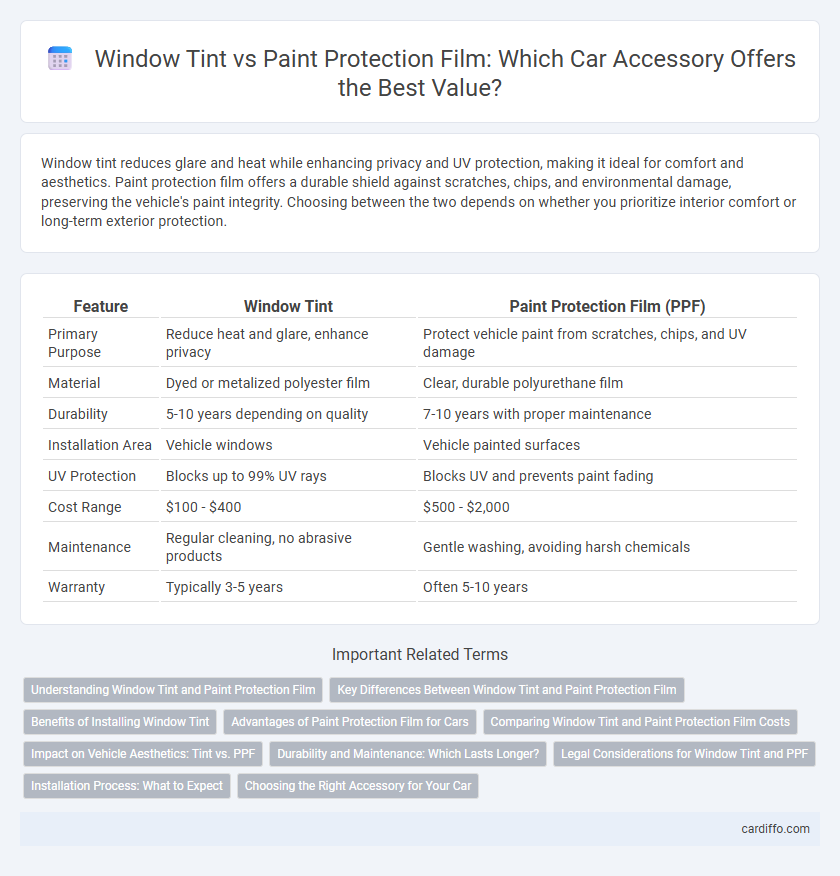Window tint reduces glare and heat while enhancing privacy and UV protection, making it ideal for comfort and aesthetics. Paint protection film offers a durable shield against scratches, chips, and environmental damage, preserving the vehicle's paint integrity. Choosing between the two depends on whether you prioritize interior comfort or long-term exterior protection.
Table of Comparison
| Feature | Window Tint | Paint Protection Film (PPF) |
|---|---|---|
| Primary Purpose | Reduce heat and glare, enhance privacy | Protect vehicle paint from scratches, chips, and UV damage |
| Material | Dyed or metalized polyester film | Clear, durable polyurethane film |
| Durability | 5-10 years depending on quality | 7-10 years with proper maintenance |
| Installation Area | Vehicle windows | Vehicle painted surfaces |
| UV Protection | Blocks up to 99% UV rays | Blocks UV and prevents paint fading |
| Cost Range | $100 - $400 | $500 - $2,000 |
| Maintenance | Regular cleaning, no abrasive products | Gentle washing, avoiding harsh chemicals |
| Warranty | Typically 3-5 years | Often 5-10 years |
Understanding Window Tint and Paint Protection Film
Window tint is a thin laminate film applied to glass surfaces to reduce heat and UV rays, enhance privacy, and improve aesthetics. Paint protection film (PPF) is a durable, clear polyurethane layer that shields a vehicle's paint from scratches, chips, and environmental damage. Both products serve protective functions but target different surfaces and offer distinct benefits in automotive care.
Key Differences Between Window Tint and Paint Protection Film
Window tint primarily reduces heat, glare, and UV rays inside a vehicle, enhancing comfort and protecting interior surfaces, while paint protection film (PPF) safeguards the vehicle's exterior paint from scratches, chips, and environmental damage. Unlike window tint, which is applied to glass surfaces, PPF is a transparent, durable material applied directly to the car's body panels for long-lasting preservation. Both accessories contribute to vehicle protection but serve distinct functions tailored to different parts and types of damage prevention.
Benefits of Installing Window Tint
Window tint significantly reduces harmful UV rays by blocking up to 99% of ultraviolet radiation, which protects the vehicle's interior from fading and cracking. It enhances privacy and safety by making it more difficult for outsiders to see inside, while also reducing glare and heat, improving driving comfort and reducing air conditioning costs. Compared to paint protection film, window tint provides superior protection against sun damage and heat without altering the vehicle's exterior appearance.
Advantages of Paint Protection Film for Cars
Paint protection film offers superior durability against scratches, rock chips, and environmental contaminants compared to window tint. It maintains the vehicle's original paint finish by providing a clear, protective barrier that resists yellowing and cracking over time. Unlike window tint, paint protection film enhances overall car preservation, adding long-term value and reducing maintenance costs.
Comparing Window Tint and Paint Protection Film Costs
Window tint generally costs between $150 and $400 for a standard car, while paint protection film (PPF) ranges from $500 to over $2,000 depending on coverage and quality. Window tint protects against UVA/UVB rays and heat, offering energy savings and UV resistance, whereas PPF provides a durable barrier against scratches, chips, and road debris. The investment in PPF tends to be higher due to its protective benefits and film thickness, making it ideal for maintaining vehicle paint over time.
Impact on Vehicle Aesthetics: Tint vs. PPF
Window tint enhances vehicle aesthetics by providing a sleek, uniform appearance while reducing glare and UV exposure, which helps maintain interior condition. Paint protection film (PPF) preserves the vehicle's original paint by shielding against scratches, chips, and environmental damage, maintaining its glossy finish over time. Both accessories contribute to a vehicle's visual appeal, but tint alters exterior perception with a darker shade, whereas PPF keeps the factory look intact while offering robust protection.
Durability and Maintenance: Which Lasts Longer?
Window tint typically lasts 5 to 10 years depending on quality and exposure to sunlight, requiring minimal maintenance such as regular cleaning with a soft cloth and mild soap. Paint protection film (PPF) offers superior durability, often lasting 7 to 10 years or more, with resistance to scratches and UV damage, but it may require occasional professional inspections to maintain its protective qualities. Both options require careful upkeep, though PPF generally provides longer-lasting protection with slightly higher maintenance demands.
Legal Considerations for Window Tint and PPF
Window tint regulations vary by state and country, specifying allowable tint darkness and reflectivity to ensure driver visibility and compliance with road safety laws. Paint protection film (PPF) typically faces fewer legal restrictions since it is clear and designed to shield vehicle paint without impairing visibility. Vehicle owners must verify local legal requirements for window tint to avoid fines, while PPF installations generally comply with regulations and provide durable protection.
Installation Process: What to Expect
Window tint installation requires precise surface cleaning and careful application of adhesive film to avoid bubbles and imperfections, typically completed within one to two hours. Paint protection film (PPF) installation involves a more intricate process including detailed surface preparation, exact cutting, and meticulous layering to ensure durability and seamless coverage, which can take several hours to a full day depending on vehicle size. Both installations demand professional expertise for optimal results, but PPF generally requires more time and skill due to its thickness and complexity.
Choosing the Right Accessory for Your Car
Window tint enhances privacy, reduces glare, and protects the vehicle's interior from UV damage, making it ideal for drivers seeking comfort and heat reduction. Paint protection film safeguards the car's exterior from scratches, chips, and environmental contaminants, preserving the paint's appearance and resale value. Selecting the right accessory depends on whether you prioritize interior protection and privacy or exterior durability and aesthetic preservation.
Window tint vs Paint protection film Infographic

 cardiffo.com
cardiffo.com